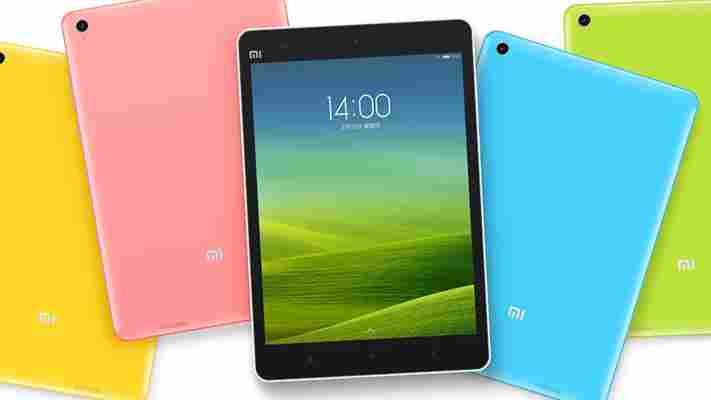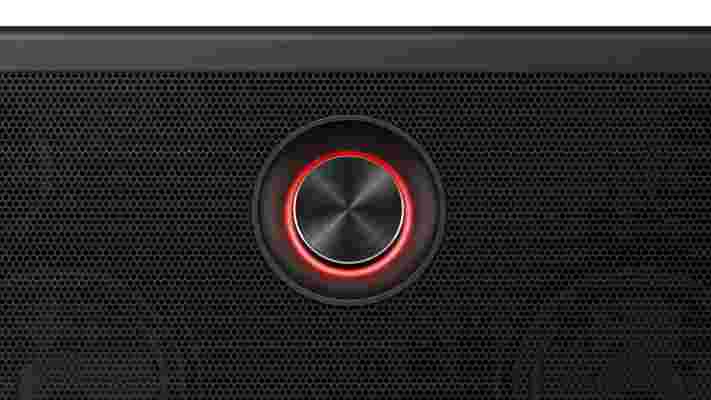Popular Chinese smartphone manufacturer Xiaomi released its first tablet today, the 7.9-inch Mi Pad, as it seeks to challenge Apple’s iPad. Xiaomi CEO and co-founder Lei Jun took to the stage to tout the top-notch specifics of the Mi Pad — in particular it is the first mobile device in the world to use Nvidia’s 2.2 Ghz Tegra K1 processor, which could give it an edge over other devices in the same price range.

What’s particularly notable is that in the case of its tablet, Xiaomi is seeking to compete not only against fellow Android manufacturers, but Apple.
The Mi Pad deliberately designed with the exact same form factor as the iPad Mini. The fact that Xiaomi freely admits to taking design tips from Apple is baffling, because it lends to the suggestion that the Mi Pad is a cheaper and less impressive version of the iPad.
The Mi Pad is made from plastic, so it’s hard to reconcile it with the sleek metallic look of the Apple iPad. Instead, the Mi Pad looks more like a larger version of Apple’s iPhone 5c — that applies right down to the multiple neon colours and the polycarbonate casing.
Weighing only 360g, the Mi Pad is relatively light (though the iPad Mini WiFi-version is slightly lighter at 331g) and easy to carry around. Yet I have a particular problem with the Mi Pad, which I believe others may encounter too — if you have sweaty palms, there’s a good chance you might struggle to keep it in your hands. Basically, any water makes the tablet slip from your grasp easily and that can make it hard to watch videos or play games for sustained periods of time.
That issue is unfortunate because it distracts from the fact that, in the Mi Pad, Xiaomi has delivered a device capable of a high-quality viewing and gaming experience. Same as Apple’s iPad, the Mi Pad sports a 2048p x 1536p screen, and it shows in the clarity of multimedia displayed on the tablet. Watching videos is a joy, as the colors burst out of the screen and the images are crisp and sharp.
Even reading has been optimized on the Mi Pad — it isn’t harsh on your eyes, and you can highlight parts of the text and find out related meanings from the dictionary.
The Mi Pad is also touted to provide a gaming experience similar to the “best” PC gameplays on the market right now. Given it is powered by the Tegra K1 processor, that should not come as a surprise. I tried out the Temple Run game and it indeed delivered. The Mi Pad responded beautifully to tilt motions and the game moved along smoothly and speedily, without any lag at all.
Xiaomi’s tablet one-ups Apple’s iPad with its eight-megapixel rear camera, which comes in handy for those fed-up with tablet manufacturers which don’t improve on the camera. Even the front-facing camera comes in at five megapixels, resulting in a better experience for video calls (and selfies).
The design of Xiaomi’s highly-customizable MIUI firmware has been tweaked with a new interface design to better suit a tablet. It essentially looks like a simplistic version of iOS 7 on the Mi Pad. Xiaomi previously said its engineers applied a whole new design language to showcase content on the tablet, come up with new animation effects and re-design the system for apps to show up optimally no matter whether the tablet is horizontal or vertical.
There is a swipe down menu that makes it easy to access frequently used services, and when you click on the multiple tabs button on the bottom left of the tablet, you can easily see which apps you have open, and something that’s very nifty — how much RAM you have available for use out of the 2GB total RAM.
Xiaomi could have developed a more efficient system for unlocking the device from standby, however. As there is no home button on the tablet like Apple’s iPad, getting access to the screen is a two-step process and made me long for the simplicity of LG’s Knock Code . For tablets in particular, having to find a button on the side then swiping upwards before you finally see your apps feels like too much trouble.
Overall, I would say the Mi Pad is great as an entry-level tablet. After all, it is retailing from 1499 yuan ($240) for a WiFi-only 16 GB version, while the 64GB version is 1699 yuan (around $273). For the sake of comparison, Apple’s 16GB iPad costs double the price in China.
It’s still not clear when the Mi Pad will officially launch. The company will begin ‘open testing’ of the device in June, which means it will make a beta version available for sale and collect initial customer feedback, which will help shape a full launch. This means the final iteration of the tablet may see some improvements.
It also isn’t clear as of now whether the tablet will make it out of China, but it seems well-suited for emerging markets — as it is equipped with top of the line specs giving it a high performance level, at a mid-range price. Xiaomi should probably just tone down the challenge to Apple’s iPad, and seek to compete with fellow Android manufacturers instead.
BlackBerry’s Indonesia-focused Z3 smartphone goes on sale for $191 this week
At Mobile World Congress in February this year, beleaguered smartphone firm BlackBerry announced that it would be launching the Z3, codenamed ‘Jakarta,’ this year. Now it has revealed that the Z3 will go on sale on May 15, this Thursday, with a price tag of IDR 2,199,000 ($191).

The Z3 is built “exclusively” for Indonesia, with an emphasis on communication, in line with BlackBerry’s new focus on messaging especially with its standalone BlackBerry Messenger app on iOS and Android now too. With a five-inch display, BlackBerry claims that the Z3 offers the “best Bahasa typing experience on a touchscreen.”
BlackBerry is also touting exclusive content for Indonesian Z3 users, including a set of BBM stickers featuring local characters which will be free for them for a limited period of time. Z3 users will also get to join local BBM channels to receive updates from various brands and opinion leaders.
BlackBerry had always been a well-used smartphone brand in Indonesia, to the point that Android — which has been growing fast across Asia over the past several years — only overtook it as the most used platform in the country in September 2012.
However, BlackBerry has steadily declined in Indonesia, with signs of its dominance coming to a close evident since 2012. Reuters recently looked at BlackBerry’s decline in Indonesia, and concluded that among other factors, the company failed to price its devices at a cost that made them widely accessible to fans of the company in the country.
As a result, cheaper Android devices, coupled with cross-platform messaging apps like WhatsApp and Line, are filling the space that BlackBerry smartphones and its BBM messenger once occupied — which explains the impetus for BlackBerry to roll out a messaging-focused smartphone targeted at Indonesian users.
Headline image via Ethan Miller/Getty Images
iLoud review: A wireless speaker for mobile musicians that lives up to its name
IK Multimedia has carved out a niche for itself over the past few years by selling low-cost, musician-friendly apps and hardware. The latest to hit the market is iLoud , a small Bluetooth speaker and audio interface designed for use with iOS and Android devices. I’ve been trying it for the past couple of weeks and I have to say I’m impressed.

First of all, let’s be clear that the name is an appropriate one. Packing 40 Watts, the iLoud went far louder than I expected of its 9.84″ x 6.3″ x 2.36″ dimensions. It’s got enough punch that you should be able to use it for busking in the street or rocking a small party.
The sound has a decent level of clarity for the speaker’s $299 price point, too. IK Multimedia is pitching this as a studio monitor-quality device and has published video comparisons with other popular speakers that give you an idea of the quality that it achieves. For optimum body to your sound, it works best placed up against a wall or piece of furniture, where bass is boosted through natural acoustics.
That said, even with it sitting on a coffee table, I listened to a variety of music through the iLoud, from bass-heavy electronica to flute-and-strings-laden Final Fantasy soundtracks without any frustration over muffled audio. Sure it’s no audiophile’s dream machine but it’s far better than you may be prepared for, based on its price.
The build quality is solid and its design is dominated by the large volume knob on the front. The knob is surrounded by a red light that indicates the power’s on but also flashes to indicate that the iLoud is in Bluetooth pairing mode.
Setting up the iLoud is as simple as pairing your iOS or Android device with it over Bluetooth and letting the music play. Although designed with mobile use in mind, it acts as a perfectly good portable speaker for your computer, too. Battery life is perfectly acceptable; I played nine hours of audio through it at a listenable but moderate level on a full charge, one hour less than the maximum ten IK Multimedia advertises for “normal usage.” I spared my neighbors a battery-life test at full volume, although the company claims “up to three hours” if you’re not quite so considerate. A full charge from flat takes about two hours.
While wireless audio playback is likely to be what most people will use the iLoud for, it’s actually a two-way device. A dynamic microphone or a guitar can be plugged into the quarter-inch jack socket and then relayed to your mobile device for recording or processing. To keep latency low, the iLoud doesn’t send audio to your device via Bluetooth. Instead, it comes with a cable that plugs into your headphone socket to act as an audio-in.
One thing to be mindful of is that the iLoud won’t act as a direct speaker for whatever you plug into the jack socket, it can only relay that audio to your mobile device. However, it works as advertised, and I was able to record audio from a microphone into GarageBand and IK Multimedia’s own iRig Recorder app on my iPhone. If I have one criticism here, it’s that the Gain control on the rear of the device is a little small and fiddly to use if you need to adjust the input level of your source.
There are plenty of cheaper portable Bluetooth speakers on the market, but iLoud’s quality, volume and musician-friendly interface impressed me, so if you’re in the market for a something that checks those boxes, it comes highly recommended.
➤ IK Multimedia iLoud
Find our latest gadgets coverage at TNW Gadgets
